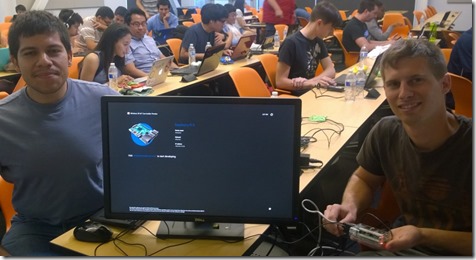Windows 10 Raspberry Pi 2+: UC Merced Graduate Students talk about their experience!
If you are getting started with IOT, check out the Microsoft Virtual Academy at:
If you want to read about students doing great things read the following!
********************************************************************************************
Dateline: May 2, 2015 Location: UC Merced
Daniel Winkler and Alex Beltran accomplished a first today: Using a Raspberry Pi 2+ with Windows 10 in a University Hackathon! These two pioneering PhD students who took on the challenge of getting the newly released Windows 10 on a Raspberry Pi 2+ is pretty amazing considering that the operating system was just released the Day before. This is the kind of people who take on the big challenges that US corporations need to recruit NOW. They speak honestly and demonstrate that they are good researchers as well.
Here is what they had to say about the event and how they used the Windows 10 on the Raspberry Pi 2+, without editing or changes. They write with a boldness that I appreciate, and they point problems that they encountered with the set-up. And they didn’t hold anything back, something I truly appreciate. This is the kind of feedback we appreciate inside of Microsoft, maybe not enjoy, but certainly appreciate.
So here is what they found:
**************Daniel Winkler and Alex Beltran wrote the following, no changes made by me*****************
Technology is moving closer to us all. This can be seen in the acceptance of wearable devices (fitbit, iWatch) and systems embedded in our surrounding environment (Nest, WeMo). As this movement has grown, it has become commonly known as the Internet of Things, or IoT, and has generated a huge following. We are PhD students at the University of California, Merced in the ANDES Lab research group, which strives to find innovative ways to use embedded systems and wireless sensor networks to improve quality of life.
We recently had the pleasure of welcoming Microsoft evangelist Sam Stokes to our University as an opportunity to bring Microsoft technology closer to the student body. As luck would have it, this visit took place just days after the release of Microsoft's Windows 10 for IoT, said to be compatible with a handful of embedded devices, including the recently released Raspberry Pi 2. Due to our familiarity with embedded devices, we decided to take a shot getting the two to work together, following the instructions provided by Microsoft.
https://ms-iot.github.io/content/GetStarted.htm
These steps guided us through the download of the Windows 10 IoT .iso file, correct installation on a compatible memory card, and the first-time setup process on the raspberry pi 2. Although the steps brought us successfully to a working version of Windows 10 IoT, there are some things we hope to see addressed in the future. For example, the instructions noted that you must have a Windows 10 machine to perform the installation steps for Windows 10 IoT. This additional requirement seems like a nuisance, especially in a research lab that does not primarily use Windows, like ours. Additionally, we found that the first-time setup will not complete if the machine is not connected to ethernet. It is understandable that the embedded device may need a connection to perform its tasks once configured and running, but it was not understood why it was necessary at first-time setup. Lastly, the first-time setup could be greatly improved by showing the user information about the progress of the current task, or even just a spinning wheel, letting the user know that the machine is still working properly. The instructions tell you to expect a wait of ~6 minutes while it goes through a series of reboots and screens with static information, but our experience took closer to 20 minutes. At each step in the process, the inclusion of some dynamic status messages would be well-appreciated. As a fully-functional debian distribution is available for the raspberry pi 2, Windows 10 IoT must improve to provide comparable features.
The possibility to run Windows 10 on an embedded device is very exciting. Although steps could be taken to make the process more accessible, we look forward to seeing what exciting applications will be developed on Windows 10 IoT in the future.
*********************** Daniel Winkler and Alex Beltran wrote the material above *****************
Well, except for the last line, which states: “we look forward to seeing what exciting applications will be developed on Windows 10 IoT in the future“, I hope that they will consider using Window 10 to develop some of those exciting applications.
